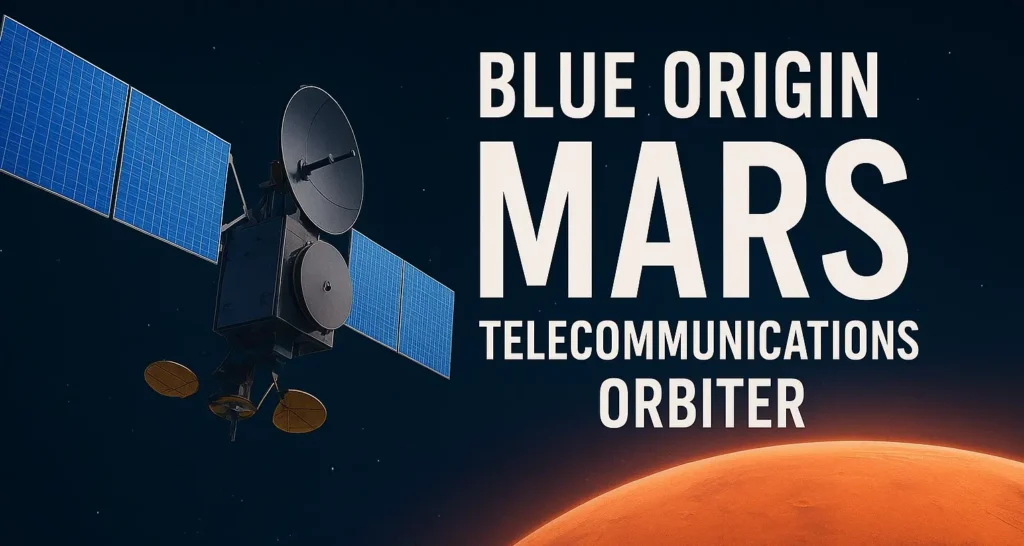In this article we’ll break down some technical aspects of Blue Origin’s MTO, but we also made a video about this topic. You can watch it here:
Blue Origin, the aerospace company founded by Jeff Bezos, has unveiled one of its most ambitious projects to date — the Mars Telecommunications Orbiter (MTO). Built on the company’s versatile Blue Ring platform, the MTO is designed to become the backbone of interplanetary communications, linking future Mars missions — robotic and human alike — to Earth in real time.
A Communications Revolution for the Red Planet
For decades, data from Mars missions has relied on a patchwork of orbiters, many of which are decades old. NASA’s Mars Reconnaissance Orbiter, Mars Odyssey, and ESA’s Mars Express have been performing the heavy lifting of relaying signals between rovers and Earth. These aging assets have kept the data flowing, but as new missions multiply and ambitions expand toward human exploration, the need for a high-bandwidth, dedicated relay infrastructure has become urgent.
That’s where Blue Origin’s Mars Telecommunications Orbiter comes in.
The MTO is more than just another deep-space probe — it’s an AI-enabled, hybrid-powered data hub capable of handling unprecedented volumes of information between Mars and Earth. According to Blue Origin, the orbiter will enable “high-speed connectivity” through multiple high-rate communication links and deployable UHF relay satellites, effectively building a communications network in Martian orbit.
The Blue Ring Platform: A Modular Foundation
At the heart of the MTO lies Blue Origin’s Blue Ring platform — a multi-purpose spacecraft bus designed for missions beyond Earth’s orbit. Built for flexibility, Blue Ring can host various payloads, from scientific instruments to communication arrays, and can operate as a long-duration orbital infrastructure node.
Blue Ring’s defining feature is its hybrid propulsion system, combining solar-electric propulsion (SEP) with traditional chemical engines. This setup allows for efficient cruising to Mars while maintaining the ability to perform high-thrust maneuvers when needed. The hybrid approach expands available launch windows, reduces fuel mass, and provides greater mission flexibility — all critical advantages for interplanetary logistics.
Smart Connectivity: Edge Computing in Space
The Mars Telecommunications Orbiter isn’t just about raw data transfer speed. It’s also about intelligence. Blue Origin emphasizes the orbiter’s onboard edge computing and AI capabilities, allowing it to process data locally before sending it to Earth.
This capability could be game-changing. Instead of streaming vast amounts of unfiltered data, the orbiter can prioritize, compress, or even analyze information in orbit. In practice, this means faster science returns, reduced latency, and more autonomous operations for future robotic explorers — and eventually, for human crews.
A Launch-Agnostic, Scalable Design
The MTO is designed to be launch-agnostic, compatible not only with Blue Origin’s upcoming New Glenn rocket but also with other heavy-lift launch vehicles featuring 5-meter fairings. This flexibility underscores Blue Origin’s intention to position the MTO as a modular, service-ready platform — a plug-and-play communication hub that can be deployed on different missions or even replicated as part of a constellation.
The Blue Ring production line is already active in Huntsville, Alabama, signaling that Blue Origin is preparing for scalability, not just a one-off prototype.
Supporting NASA’s 2028 Mars Mission — and Beyond
Blue Origin’s MTO concept aligns closely with NASA’s proposed Mars relay mission, currently slated for 2028. As part of NASA’s broader Mars Sample Return and future human mission architecture, reliable high-speed communications are essential.
Blue Origin’s system could complement or even replace legacy orbiters, ensuring continuous coverage, higher data throughput, and reduced communication lag. More strategically, the company emphasizes that up to 80% of its lunar technology — developed for Blue Moon landers and cislunar infrastructure — can be repurposed for Mars, reducing development costs and accelerating deployment.
The Bigger Picture: Toward a Martian Internet
While the technical specifications of MTO — such as data rates, antenna dimensions, and power budgets — remain undisclosed, its intent is clear: to establish a permanent interplanetary communications infrastructure.
In many ways, the MTO represents the next logical step in Blue Origin’s long-term vision of enabling “millions of people to live and work in space.” Before humans can thrive on Mars, the planet must be connected — reliably, securely, and at scale.
If successful, the Mars Telecommunications Orbiter won’t just link Earth and Mars. It will link the future of humanity across two worlds.
Key Technical Highlights
| Feature | Specification / Description |
|---|---|
| Platform | Blue Origin “Blue Ring” |
| Payload Capacity | >1,000 kg to Mars orbit |
| Propulsion | Hybrid: Solar Electric + Chemical |
| Primary Mission | Mars telecommunications relay |
| Special Features | Edge computing, AI, deployable UHF relays |
| Launch Vehicle | Compatible with New Glenn & 5m-class rockets |
| First Mission Target | NASA’s 2028 Mars relay program |
In essence, Blue Origin’s Mars Telecommunications Orbiter isn’t just a spacecraft — it’s a statement of intent. By merging modular spacecraft design, hybrid propulsion, and AI-driven autonomy, Blue Origin is signaling its readiness to help build the digital backbone of humanity’s interplanetary future.



